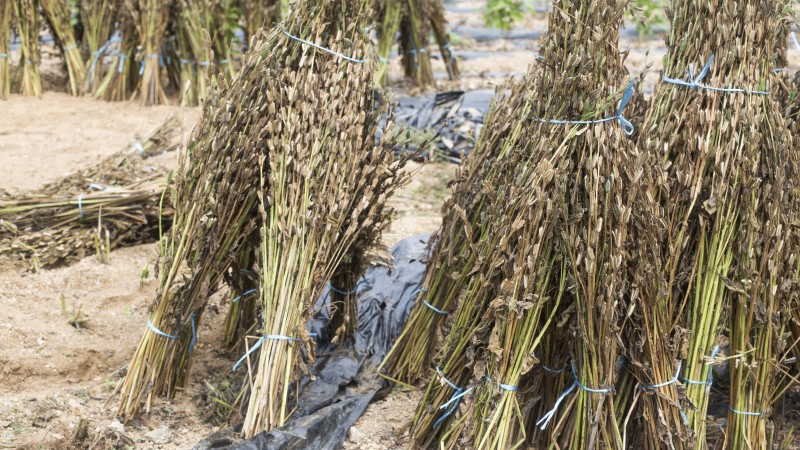In agricultural commodities, sesame seed has emerged as an unsung hero, particularly in Tanzania. Despite its relatively low global profile compared to crops like coffee or cocoa, sesame’s popularity is rising, promising significant economic benefits to Tanzania. Data Bridge Market Research analyzes that the global sesame seeds market is growing at a CAGR of 2.40% in the forecast period of 2022-2029 and is estimated to reach USD 8,147.13 million by 2029.
Over 21,000 tonnes of the produce have been sold so far, generating nearly Sh 80 billion for farmers in Lindi and Mtwara regions. Reports from the sesame-growing areas show that the crop has been traded at a maximum price of over Sh4,000 and a minimum price of Sh3,665 per kilo. Lindi Mwambo Cooperative Union (LMCU) and Ruangwa, Nachingwea, and Liwale Cooperative Union (Runali) have jointly sold over 10,881 tonnes worth nearly Sh40 billion. Over 10,200 tonnes of the produce have been sold by members of the Masasi and Mtwara Cooperative Union (Mamcu), garnering over Sh40 billion for farmers.
Sesame seed is one of the oldest oil seeds, and its incredible nutritional content and health benefits have made it popular among customers. These seeds are small and flat in shape and come in various colors, such as white, black, and brown. These seeds are high in both oil-soluble and water-soluble antioxidants, beneficial for good health.
Sesame seeds are used in various ways, including the production of culinary oils, also used in the baking industry for confectionary products and in the cosmetics sector.
The rapid rise in awareness among people about the health benefits of sesame seeds will influence the sesame seeds market. Furthermore, changing lifestyles and an upsurge in the level of investment for developing advanced products in the form of hybrids are some macroeconomic factors that positively impact the worldwide sesame seeds market.
Other factors, including changing consumer consumption patterns and increasing awareness about health, will cushion the market’s growth rate. The increase in disposable income and easy availability of advanced technology in the food industry will flourish the growth rate of the sesame seeds markets.
Sesame seeds are projected to be consumed by an increasing number of people who suffer from excessive cholesterol and blood pressure, which will propel the growth rate of the sesame seeds market. In addition, the rising number of diabetic patients is expected to enhance the sesame seeds market’s growth over the forecast period.
Tanzania’s Sesame Success: A Global Demand Story
Sesame seed’s burgeoning demand in the international market, primarily driven by the food industry, is a crucial factor behind its increasing profitability. In Asian cuisine, sesame is a staple in cooking oil, garnishing, and condiments. Moreover, the surge in global health consciousness has spotlighted sesame’s high nutritional consumer, including proteins, essential fats, and antioxidants, driving its demand for health wellness foods.
A case in point is China, the world’s leading importer of sesame seeds, where consumption has grown at an annual rate of about 13% in recent years. According to the United Nations Commodity Trade (UN Comtrade) database, China’s imports of sesame seeds, including from Tanzania, reached nearly 1 million tons in 2019, up from about 634,000 tons in 2015.
Tanzania’s geography and climate make it ideal for sesame cultivation. Sesame is a complex crop, resistant to drought conditions, and thrives in the well-drained sandy loam or clay loam soils in many parts of the country. It grows particularly well in Lindi, Mtwara, Ruvuma, and Coast regions, providing temperature and rainfall conditions.
The Tanzanian government has recognized the sesame sector’s potential and actively encouraged its cultivation. Efforts have included the introduction of improved sesame varieties, provision of farming inputs, and training programs for farmers. The government has also been working to link farmers with buyers and processors, both domestically and internationally.
According to the Tanzania National Bureau of Statistics, sesame production has been rising steadily. In the 2018/2019 agricultural season, Tanzania produced about 164,000 tons of sesame seeds, a significant increase from 124,000 tons in the 2014/2015 season. The sesame industry provides livelihoods for many Tanzanians, especially in rural areas. Sesame cultivation requires relatively low input costs, and with the right support and resources, smallholder farmers can increase their yields and income significantly.
Moreover, the hardiness of the sesame plant makes it a reliable crop in the face of climate change, offering a degree of food and income security for farming communities. Export earnings from sesame are also contributing to Tanzania’s economy. The UN Comtrade data shows that Tanzania’s exports of sesame seeds amounted to over $57 million in 2019, up from around $24 million in 2015.
Despite its potential, the sesame sector in Tanzania faces challenges, including low productivity due to traditional farming practices, post-harvest losses, and limited access to finance and markets for smallholder farmers. Addressing these issues is crucial for the sector to realize its full potential.
In conclusion, the rise of the sesame industry in Tanzania can be attributed to growing global demand, favorable conditions, and increased government support. While challenges remain, the sesame sector holds promising potential for Tanzania’s economy, particularly for smallholder farmers’ livelihoods. The sesame sector could significantly contribute to Tanzania’s agricultural economy with targeted investments and policy interventions to address existing hurdles.


Can we have the profitability analysis of the sesame production at the farmers’ level and wholesale side